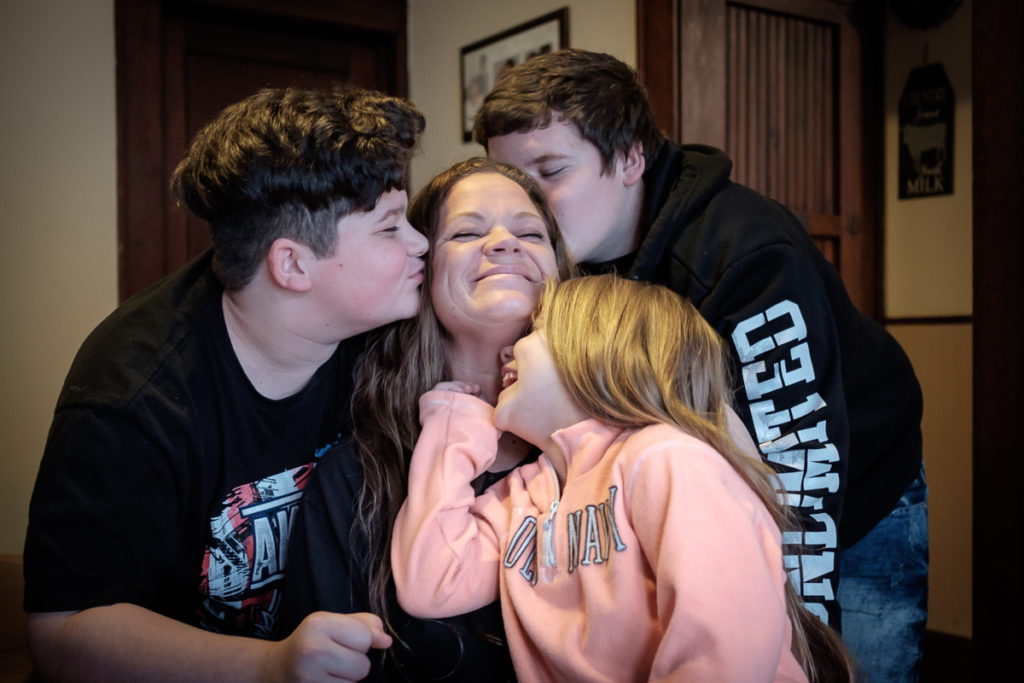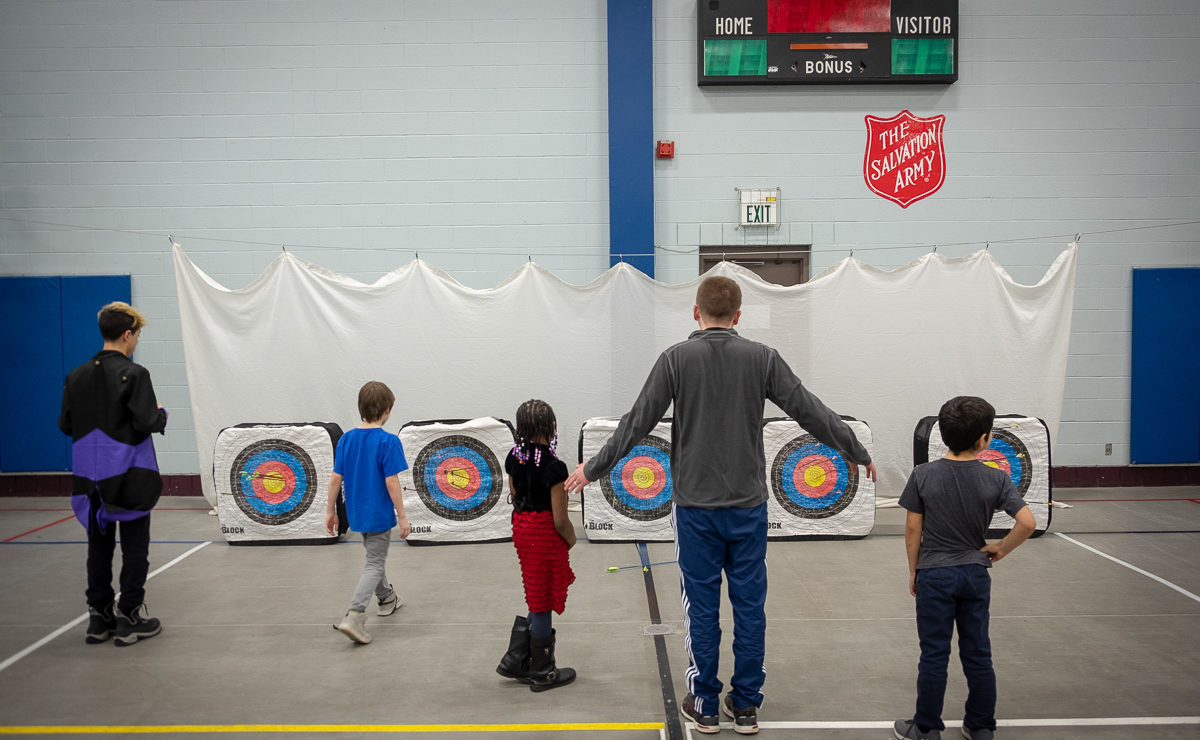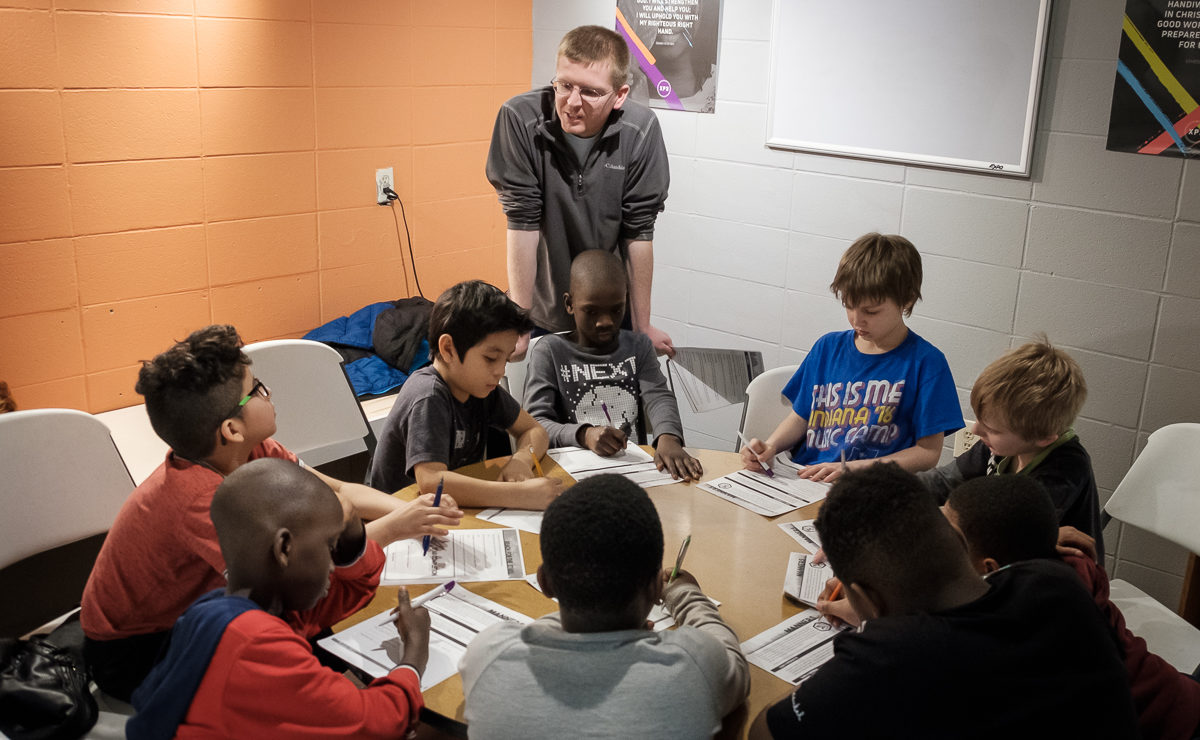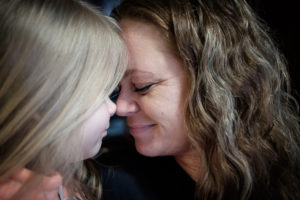What does stability feel like? Fifteen-year-old Braxton can define it with precision. “When you have somewhere to sleep at night. You have food, you have a house, you know your mom’s doing good,” he says, sitting with his family around the dining room table at their Terre Haute, Ind., home as sunlight streams though a window.
Today, Braxton’s mom, Jamie, and her children are experiencing stability after a hard, downward spiral. Struggling with a methamphetamine addiction in 2018, Jamie found herself without food or a place to live. Her boyfriend was arrested, her car was impounded, and her 13-year-old son Robby was on suicide watch. “I had no way to pick Robby up from the hospital,” Jamie says. “If you can’t help your kids, you know you’re in trouble.”
Enter The Salvation Army’s Pathway of Hope program.

Caseworker Elizabeth Little
Jamie arrived at The Salvation Army, still under the influence, desperate for hope. Caseworker Elizabeth Little did a needs assessment. “First we focused on the basics,” says Little. “Once I know that her belly is full and she’s clean, we tackle the addiction. The only qualifications to get help from Pathway of Hope are the presence of dependent children and a clear motivation to change.”
Pathway of Hope is The Salvation Army’s data-driven social service program engineered to help low-income families halt the destructive cycle of poverty. A $4.8 million grant from Lilly Endowment in 2013 funded a pilot in The Salvation Army’s central region, an area that encompasses 11 Midwestern states. A three-year, $10 million grant awarded in 2018 will enable The Salvation Army to expand the number of families served through the program nationally from 2,000 in 2018 to 9,500 by 2023. The program now operates in all of The Salvation Army’s territories, with 500 Salvation Army “corps” offering Pathway of Hope in some 40 states.
“…among all children under 18 in the U.S., 41 percent are children in low-income families and 19 percent—approximately one in five—are poor.”
The program marks an innovative shift for the 153-year-old Salvation Army, which has historically provided poverty relief by providing hot meals and groceries, help with rent and utility payments and assistance with medical bills, among other short-term support. Pathway of Hope is different because it offers targeted, wraparound services to families so they can break the cycle of poverty. Also, the program equips Salvation Army caseworkers with community resources outside of The Salvation Army itself so that they can help families through a network of referrals and support.
“We had been a place where people knew they could come in an emergency, from crisis to crisis,” says Susan Solmon, social services director of The Salvation Army’s Indiana Division, which helped implement Pathway of Hope in Indiana. “We were doing some really, really good things; our numbers were incredible. But were these services solving the problem? So, we made a commitment to a multi-generational approach, showing families that life could be different.”
What is at stake with this work? The futures of children like Braxton.
“We think of the U.S. as the land of opportunity and upward mobility,” says Sabrina Kiser, assistant director of social services and public policy coordinator at The Salvation Army’s national headquarters. “But the statistics are startling: among all children under 18 in the U.S., 41 percent are children in low-income families and 19 percent—approximately one in five—are poor.”
Kiser says that children who grow up in poverty are 32 times more likely to be in poverty as adults than children who do not, according to the Urban Institute, a Washington-based organization that provides research about the well-being of people and places in the United States. Kiser also sites research from the National Center for Children in Poverty at Columbia University, which stated that having a parent who works is often no buffer from poverty: 53.5 percent of low-income children and 32 percent of poor children live with at least one parent employed full time, year round.
To help change a family’s trajectory, Pathway of Hope caseworkers are trained to help clients set goals and to help connect them to community-based resources. Those resources can include addiction recovery programs, educational support, job training and mental health care.
“I show them other options—that there is a way out,” caseworker Little explains.
Building a structure, measuring success
Three elements distinguish the program from other anti-poverty efforts, and even from some Salvation Army programs of the past: strong infrastructure, robust metrics and a longer-term view. The Endowment grant has helped The Salvation Army fund training for staff members so they can learn best practices in case management, such as connecting families to a cross-referral network of resources. Staff are also learning to track program outcomes in a customized database.
The database provides income levels, education attainment and work history, among other demographics. Salvation Army staff can measure progress in these areas once a family enters the Pathway of Hope program. Using a social science diagnostic tool called the Herth Hope Index, caseworkers evaluate a family’s level of positive expectation. “How hopeful is the family that their lives and their children’s lives can be better?” Kiser says. “Our main goal is that they have that hope as they walk out our doors.”

Jamie and her children
Mental health, for example, is one of fifteen “life domains” on the Self-Sufficiency Matrix, another tool The Salvation Army uses to measure the success of Pathway of Hope. When Jamie first entered the program, her son Braxton had spent time in juvenile detention. But with his mom’s success at stabilizing the family, he’s making his own effort to face challenges differently. “I got punched at school today. But I let the teacher handle it,” he says, with subtle pride.
What personal testimonies suggest, data confirm. In a long-term partnership with the Center for Research on Self-Sufficiency (CROSS) at Loyola University Chicago, The Salvation Army is scientifically appraising the “hope” in Pathway of Hope.
“We began by analyzing exit surveys taken by 2,500 people served by the Pathway of Hope pilot,” says Philip Hong, founding director of CROSS. He and his colleagues looked at each participant’s unique combination of barriers, hope and sufficiency. Hong used a scale of 27 barriers to employment, including domains of physical and mental health, labor market exclusion, child care, human capital and soft skills. Combining this information with the hope and sufficiency indexes, Hong’s team was able to score Pathway of Hope participants—and validate the program’s premise with data.
“We found that hope continues to increase in the program,” he says. “Hope contributes to sufficiency. And readiness to change is a great predictor of hope and sufficiency.”
Focus groups with program staff and clients provided more insight about how staff and clients develop and sustain their hope. “We learned that for all involved, setting goals is very important and so is having the courage to face barriers,” Hong says. “Hope is what allows them to stick to goals as they overcome individual, family and societal barriers.”





Drawing an upward trajectory
When caseworker Elizabeth Little first sat down with Jamie, they lasered in on goals: getting sober, getting Jamie’s car back, and next, finding employment and improving family relations. Five months after entering Pathway of Hope, Jamie has met all of these goals. She works at a greenhouse in Terre Haute for slightly more than minimum wage, planting and processing tulips for shipment to regional grocery stores.
Addiction to methamphetamine was her trigger for tragedy. “It’s very lonely when you are an addict,” Jamie says. “Sometimes you just need somebody to chase you down and let you know that they care.”
Addiction is one of many barriers to hope. “In Indiana, we have pockets of long-term generational poverty,” says Solmon of The Salvation Army’s Indiana Division. “Some communities don’t have a lot of resources, but we do our best to refer people who need addiction treatment to treatment services nearby.”
“My goals now are to continue to stay sober and working, and I’m working hard at making sure my kids are taken care of,” Jamie says. “And maybe get some better pay. I want to keep myself and my family stable.”
Jamie and Little have a bond. The caseworker sees a bit of her own experience reflected in Jamie’s. “Because I didn’t have that perfect ‘mom-and-dad-picket-fence’ life,” she says. “The truth is, everybody deserves to be loved and listened to.”

Jamie and her daughter
This peer-to-peer approach is no accident. Upending the top-down approach to social service is baked into the design of Pathway of Hope. Hong witnessed the results in focus groups. “This relationship process of high-touch, genuine care and connecting with the spiritual aspect is critical to earning participants’ trust,” he says. “The cultivation of the relationship results in the individual’s maintaining hope to overcome the barriers and strengthen the readiness to change,” Hong says. “The scaffolding and referrals the staff provides are critical to an individual’s feeling cared for and ready for a first line of success. She can call the caseworker to say: ‘I got my first job!’”
The power of empathic care
Spiritual care, an overt tenet of The Salvation Army’s mission, plays an understated role in Pathway of Hope.
“As we assess a family’s motivation to change, it’s a good time to invite them to reflect on their spiritual life at the moment,” Kiser says. “While there’s always someone on the care team prepared to assist with spiritual development when requested, spiritual care does not have to be religious. It can involve character education or simply an encouraging word from a pastor.”
Salvation Army pastoral care staff stand by, if desired, to connect participants to their preferred faith tradition. For example, Pathway of Hope staff in Dearborn, Mich., referred a struggling family to Muslim community leaders as part of the road to recovery.
Hong sees this as a great example of Pathway’s service mindset. “Unintentionally, some social service programs play a gatekeeper role, more of a trickle-down approach to social service,” he says. “But in this case, Pathway of Hope has reinvigorated The Salvation Army’s mission of service to the family. We are finding that empathetic care is what makes this a strong model.”
Notably, the empathy extends to the staff. Caseworkers receive support for maintaining their energy as caring resources. One of the goals for the Endowment grant, says Kiser, is increasing the number of full-time case managers. That will require grant writers to sustain an increase in staff, which will include more coordinators to train caseworkers on database input and community engagement. Three million dollars of the Endowment’s grant is designated for a $1-to-$1 match to leverage future support.
Charting futures
A year into their Pathway of Hope journey, Jamie and her children are experiencing new life. “We have a home. We come home and we try to have dinner around the table in the evenings,” Jamie says. “Being able to talk to each other and know that we have each other to lean on means a lot. My kids are all the motivation I need to keep clean.”
Braxton says he is proud of his mom. And he’s imagining his own future. “I’m going to go to college to be a diesel mechanic and set my own goals and be successful and help whoever I can,” he says, making eye contact.
Caseworker Little recalls the day Jamie called her, crying … from joy. “She said: ‘It’s the first time we paid every bill. So, we went out to eat for dinner.’” Braxton remembers that special dinner well. “We went to the Hacienda,” he adds, smiling.
“It’s amazing how strong people are,” says Solmon of The Salvation Army Indiana Division. “Once they determine what they want for themselves, they just need someone to come alongside them, believe in them and work together in hope.”
This three-year grant, awarded in 2018, will enable The Salvation Army to expand the number of families served through the Pathway of Hope program nationally from 2,000 in 2018 to 9,500 by 2023.